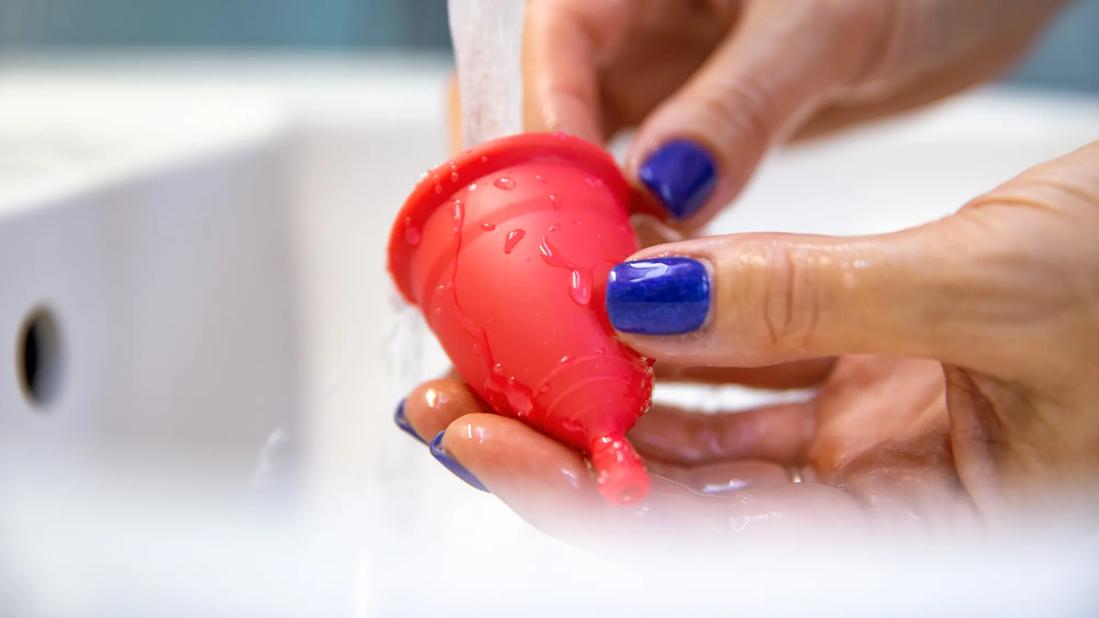These substitutes for tampons and pads can be a great option for lower cost, lower carbon footprint and longer wear times

Menstrual cups have become a popular alternative to tampons and pads. Some are long-lasting and reusable, while others are disposable. But what are they, exactly? And are they the right fit for your period needs?
Advertisement
Cleveland Clinic is a non-profit academic medical center. Advertising on our site helps support our mission. We do not endorse non-Cleveland Clinic products or services. Policy
Ob/Gyn Karmon James, MD, explains how menstrual cups work and shares the pros and cons of using them — plus, how to use them if you do decide to make the switch.
A menstrual cup is a flexible cup, made of either silicone or rubber, that you insert into your vagina to collect period blood.
Menstrual cups don’t absorb blood the way tampons or pads do. Instead, you can think of one like catching raindrops in a bucket: Your period blood stays in the cup until you remove it from your body and empty its contents.
You may also hear them referred to as:
“These products have been proven to be safe and very effective,” Dr. James says. “And unlike tampons, most of them are designed to be reusable.”
One study found that it took most users about three menstrual cycles to get used to using a cup, in terms of insertion, removal and overall comfort. Once they adjusted, though, the majority of users said they preferred cups to other menstrual hygiene options.
So, are menstrual cups right for you? Let’s take a closer look at their benefits.
Advertisement
There are two sides to every coin. Dr. James explains some possible downsides of using a menstrual cup.
Various brands of menstrual cups are sold online and in stores. And most of them come in small or large versions. Here are a few considerations to help you figure out which type is right for you.
“It never hurts to do a little research,” Dr. James encourages. “Compare the options that are out there and read the reviews to see what other people are saying.”
If the first menstrual cup you buy doesn’t suit you, the next size — or a different brand — might do the trick.
There can be a bit of a learning curve to figuring out how to insert and remove a menstrual cup.
“If you’ve ever used tampons, especially the kind without an applicator, you should have little trouble learning how to insert a menstrual cup,” Dr. James says. “And if you’ve ever used a vaginal ring for birth control, you’ll have even less trouble.”
Advertisement
Still, it may take some trial and error to get it right. She walks us through the steps.
Follow these steps to successfully insert a menstrual cup:
You shouldn’t feel pain when you insert a menstrual cup. If you do, stop using it and talk to your healthcare provider.
If you’ve inserted your menstrual cup properly, you shouldn’t be able to feel it. So, once it’s in place, feel free to go about your day as normal.
If you experience leakage while wearing a menstrual cup, it could be a sign that it’s been inserted wrong. Or it could be a sign that the cup has been in too long and is full.
Advertisement
“You can use a cup throughout your cycle,” Dr. James says, “but you might need to change it more often on heavy flow days to guard against leaking.”
Here’s how to take out your menstrual cup:
It’s important to wash your menstrual cup each time you remove it. Again, you should always use a fragrance-free soap to clean it before you insert it, as scented soap can cause irritation.
“When your period ends, you’ll want to clean and fully sanitize the cup,” Dr. James advises. “This helps remove any bacteria that could damage the cup or lead to an infection the next time you use it.”
Advertisement
To sanitize your menstrual cup, you can typically clean it as usual, then put it in a pot of boiling water for a few minutes. Some products come with more specific instructions, though, so be sure to read the packaging.
After you’ve sanitized your cup, let it cool off and air dry before you store it for the next month — usually in a pouch or other container that it came with. Between periods, keep it in a cool, dry place like a drawer or linen closet.
Ultimately, the only way to know if a menstrual cup will work for you is to buy one and give it a try. But you don’t have to try to figure it all out on your own.
“If you have concerns about using a menstrual cup, including insertion or removal, always talk to your healthcare provider,” Dr. James urges. “They can even walk you through the process during an office visit.”
Learn more about our editorial process.
Advertisement

Stress, PCOS, perimenopause or hyperthyroidism may cause a low flow

Pads are a low-effort option for period management and come in different absorbencies, materials and shapes

Heat therapy, light exercise and anti-inflammatory medications can bring relief

Fluctuating hormones, water retention and a change in habits can cause temporary weight gain

Stress can cause light, late or nonexistent periods — which may eventually create a hormonal imbalance

Your period typically gets darker as the days go on, starting out pink and changing to red, dark red and even brown

Foods with iron, antioxidants and fiber can help you feel your best

If you wash regularly and change your underwear as needed, this can be a safe (and liberating) alternative to pads and tampons

You can improve your athletic performance over time by breaking up your workout regimen into focused cycles

The little blue pill might help with physical arousal, but there are better treatments for low libido in women

Sleep issues and certain foods can lead to an early morning headache